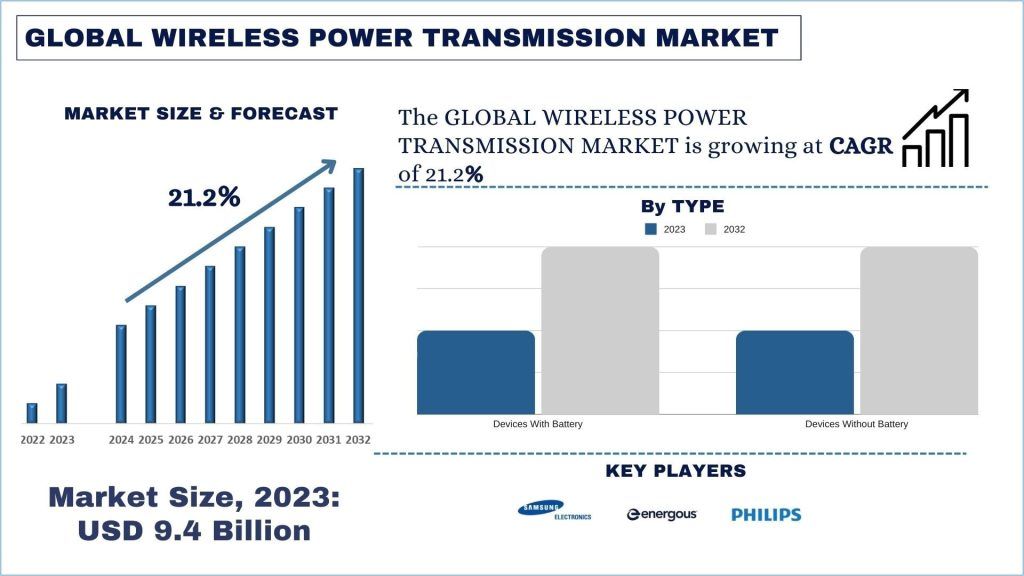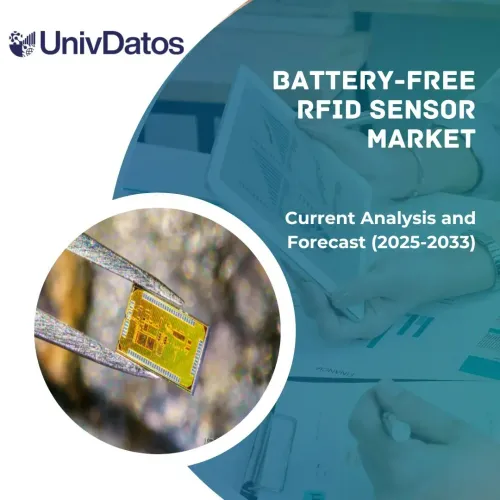- Trang chủ
- Về chúng tôi
- Ngành
- Dịch vụ
- Đọc
- Liên hệ với chúng tôi
Phân tích và Dự báo Thị trường Truyền tải Điện không dây (2024-2032)
Nhấn mạnh theo Loại (Thiết bị có Pin và Thiết bị không có Pin); Công nghệ (Công nghệ Cận trường và Viễn trường); Ứng dụng (Bộ thu và Bộ phát); Khu vực/Quốc gia.
Quy mô & Dự báo Thị trường Truyền tải Điện không dây
Thị trường Truyền tải Điện không dây được định giá 9,4 Tỷ USD vào năm 2023 và dự kiến sẽ tăng trưởng với tốc độ CAGR mạnh mẽ khoảng 21,2% trong giai đoạn dự báo (2024-2032) do việc áp dụng ngày càng tăng trong xe điện (EV).
Phân tích Thị trường Truyền tải Điện không dây
Thị trường Truyền tải Điện không dây đang trải qua sự tăng trưởng và chuyển đổi nhanh chóng, được thúc đẩy bởi những tiến bộ công nghệ, nhu cầu của người tiêu dùng ngày càng tăng về sự tiện lợi và việc áp dụng ngày càng tăng của xe điện (EV). Truyền tải điện không dây liên quan đến việc truyền năng lượng điện mà không cần đầu nối vật lý hoặc cáp, cung cấp một giải pháp liền mạch và hiệu quả để sạc nhiều loại thiết bị. Công nghệ này bao gồm một số phương pháp, bao gồm ghép nối cảm ứng, ghép nối cảm ứng cộng hưởng, truyền năng lượng tần số vô tuyến (RF) và truyền năng lượng dựa trên laser, mỗi phương pháp có các ứng dụng và ưu điểm riêng.
Lĩnh vực điện tử tiêu dùng là một trong những động lực chính của Thị trường Truyền tải Điện không dây. Khi điện thoại thông minh, máy tính bảng, thiết bị đeo và các thiết bị di động khác trở nên không thể thiếu trong cuộc sống hàng ngày, nhu cầu về các giải pháp sạc hiệu quả và thân thiện với người dùng đã trở nên tối quan trọng. Đế sạc và bề mặt sạc không dây ngày càng trở nên phổ biến trong gia đình, văn phòng và không gian công cộng, mang đến cho người dùng sự tiện lợi khi chỉ cần đặt thiết bị của họ lên một bề mặt để sạc mà không cần xử lý các loại cáp rối và đầu nối bị mòn.
Lĩnh vực chăm sóc sức khỏe cũng là một lĩnh vực đáng chú ý được hưởng lợi từ công nghệ truyền tải điện không dây. Các thiết bị y tế, chẳng hạn như thiết bị cấy ghép, thiết bị theo dõi sức khỏe có thể đeo và cảm biến y tế, yêu cầu các giải pháp năng lượng đáng tin cậy và hiệu quả. Sạc không dây đáp ứng những nhu cầu này bằng cách loại bỏ nhu cầu về các thủ tục xâm lấn để thay thế pin trong các thiết bị cấy ghép và bằng cách cung cấp một giải pháp năng lượng thuận tiện hơn cho thiết bị đeo và cảm biến. Công nghệ này nâng cao sự thoải mái và an toàn cho bệnh nhân đồng thời cải thiện độ tin cậy và khả năng sử dụng của các thiết bị y tế. Nhìn chung, Thị trường Truyền tải Điện không dây được dự báo sẽ tăng trưởng đáng kể, với các ứng dụng trải rộng trên lĩnh vực điện tử tiêu dùng, xe điện, chăm sóc sức khỏe, tự động hóa công nghiệp và nhà thông minh. Những tiến bộ liên tục trong công nghệ, cùng với nhu cầu của người tiêu dùng ngày càng tăng và các khuôn khổ pháp lý hỗ trợ, được thiết lập để thúc đẩy việc áp dụng và tích hợp rộng rãi các giải pháp truyền tải điện không dây trong các khía cạnh khác nhau của cuộc sống hiện đại.
Xu hướng Thị trường Truyền tải Điện không dây
Phần này thảo luận về các xu hướng thị trường chính đang ảnh hưởng đến các phân khúc khác nhau của thị trường Truyền tải Điện không dây, như được xác định bởi nhóm các chuyên gia nghiên cứu của chúng tôi.
Chính sách của Chính phủ Hỗ trợ Ngành Truyền tải Điện không dây:
Chính phủ trên toàn thế giới ngày càng nhận ra tiềm năng của công nghệ truyền tải điện không dây để nâng cao hiệu quả năng lượng, giảm tác động đến môi trường và hỗ trợ sự phát triển của cơ sở hạ tầng thông minh. Một số chính sách và sáng kiến đã được thực hiện để hỗ trợ sự phát triển và ứng dụng của công nghệ này:
Ưu đãi cho Xe điện (EV):Nhiều chính phủ cung cấp trợ cấp, giảm thuế và các ưu đãi cho việc mua xe điện, thường bao gồm các điều khoản dành cho cơ sở hạ tầng sạc EV không dây. Các chính sách này thúc đẩy việc áp dụng truyền tải điện không dây trong lĩnh vực ô tô.
Tài trợ cho Nghiên cứu và Phát triển: Chính phủ cung cấp các khoản tài trợ và tài trợ cho nghiên cứu và phát triển các công nghệ truyền tải điện không dây. Sự hỗ trợ này giúp thúc đẩy đổi mới và đẩy nhanh thương mại hóa các giải pháp sạc không dây mới.
Tiêu chuẩn và Chứng nhận Quy định: Thiết lập và thực thi các tiêu chuẩn, chẳng hạn như tiêu chuẩn sạc không dây Qi, đảm bảo khả năng tương tác và an toàn của các thiết bị sạc không dây. Các cơ quan quản lý làm việc với các bên liên quan trong ngành để tạo ra một khuôn khổ nhất quán, thúc đẩy sự tin tưởng của người tiêu dùng và tăng trưởng thị trường.
Sáng kiến Thành phố thông minh: Các dự án thành phố thông minh do chính phủ dẫn đầu thường kết hợp các công nghệ truyền tải điện không dây để hỗ trợ việc triển khai các thiết bị IoT, lưới điện thông minh và hệ thống giao thông tự động. Các sáng kiến này tạo ra một môi trường thuận lợi cho việc áp dụng các giải pháp sạc không dây trong cơ sở hạ tầng đô thị.
Chính sách Bền vững và Môi trường: Chính phủ đang thúc đẩy việc sử dụng các nguồn năng lượng sạch và bền vững. Truyền tải điện không dây, khi được tích hợp với các hệ thống năng lượng tái tạo, phù hợp với các mục tiêu môi trường này bằng cách cung cấp các giải pháp sạc hiệu quả và thân thiện với môi trường.
Chương trình Phát triển Cơ sở hạ tầng: Đầu tư vào cơ sở hạ tầng công cộng, chẳng hạn như trạm sạc không dây cho xe điện và đế sạc công cộng cho thiết bị điện tử tiêu dùng, được hỗ trợ bởi tài trợ của chính phủ và quan hệ đối tác công-tư. Các chương trình này giúp xây dựng cơ sở hạ tầng cần thiết để hỗ trợ việc áp dụng rộng rãi truyền tải điện không dây.
Các chiến dịch Giáo dục và Nâng cao nhận thức: Chính phủ tiến hành các chiến dịch giáo dục để nâng cao nhận thức về lợi ích của các công nghệ truyền tải điện không dây. Các chiến dịch này nhắm đến người tiêu dùng, doanh nghiệp và các bên liên quan trong ngành để thúc đẩy sự chấp nhận và ứng dụng.
Chính sách Thương mại và Đầu tư: Các chính sách thương mại và ưu đãi đầu tư thuận lợi khuyến khích các công ty trong và ngoài nước đầu tư vào thị trường truyền tải điện không dây. Các chính sách này giúp thu hút vốn và chuyên môn, thúc đẩy tăng trưởng và phát triển ngành.
Nhìn chung, các chính sách của chính phủ đóng một vai trò quan trọng trong việc hỗ trợ Ngành Truyền tải Điện không dây bằng cách cung cấp các ưu đãi tài chính, thiết lập các tiêu chuẩn quy định, thúc đẩy nghiên cứu và phát triển và tạo ra một môi trường thuận lợi cho việc áp dụng các giải pháp sạc sáng tạo.
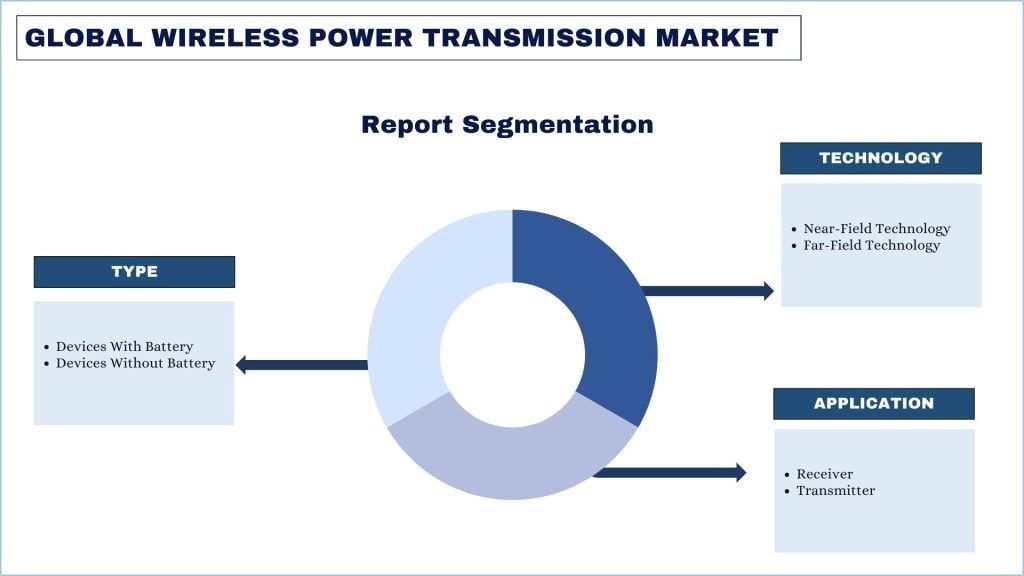
APAC dự kiến sẽ tăng trưởng với CAGR đáng kể trong giai đoạn dự báo
APAC ghi nhận thị phần cao nhất trên thị trường Truyền tải Điện không dây và dự kiến sẽ chứng kiến CAGR có ảnh hưởng trong giai đoạn dự báo. Động lực chính của Thị trường Truyền tải Điện không dây ở khu vực Châu Á - Thái Bình Dương (APAC) là sự tăng trưởng nhanh chóng của điện tử tiêu dùng và việc áp dụng ngày càng tăng của xe điện (EV). Khu vực này là nơi có một số thị trường điện tử tiêu dùng lớn nhất thế giới, với các quốc gia như Trung Quốc, Nhật Bản, Hàn Quốc và Ấn Độ dẫn đầu về sản xuất và tiêu thụ điện thoại thông minh, máy tính bảng, thiết bị đeo và các thiết bị di động khác. Nhu cầu cao về thiết bị điện tử tiêu dùng này thúc đẩy nhu cầu về các giải pháp sạc không dây tiện lợi và hiệu quả, thúc đẩy sự tăng trưởng của thị trường. Ngoài ra, khu vực APAC đang chứng kiến sự gia tăng đáng kể trong việc áp dụng xe điện, được thúc đẩy bởi các sáng kiến của chính phủ, quy định về môi trường và những tiến bộ công nghệ. Các quốc gia như Trung Quốc và Nhật Bản đang đầu tư mạnh vào cơ sở hạ tầng EV, bao gồm các trạm sạc không dây, để hỗ trợ số lượng EV ngày càng tăng trên đường. Điều này thúc đẩy nhu cầu về các công nghệ truyền tải điện không dây trong lĩnh vực ô tô. Hơn nữa, sự tập trung mạnh mẽ của khu vực vào đổi mới công nghệ và sự hiện diện của các công ty công nghệ lớn góp phần vào sự tiến bộ và ứng dụng các giải pháp truyền tải điện không dây. Các công ty này đang đầu tư vào nghiên cứu và phát triển để nâng cao hiệu quả và khả năng của công nghệ sạc không dây, thúc đẩy thị trường phát triển hơn nữa.
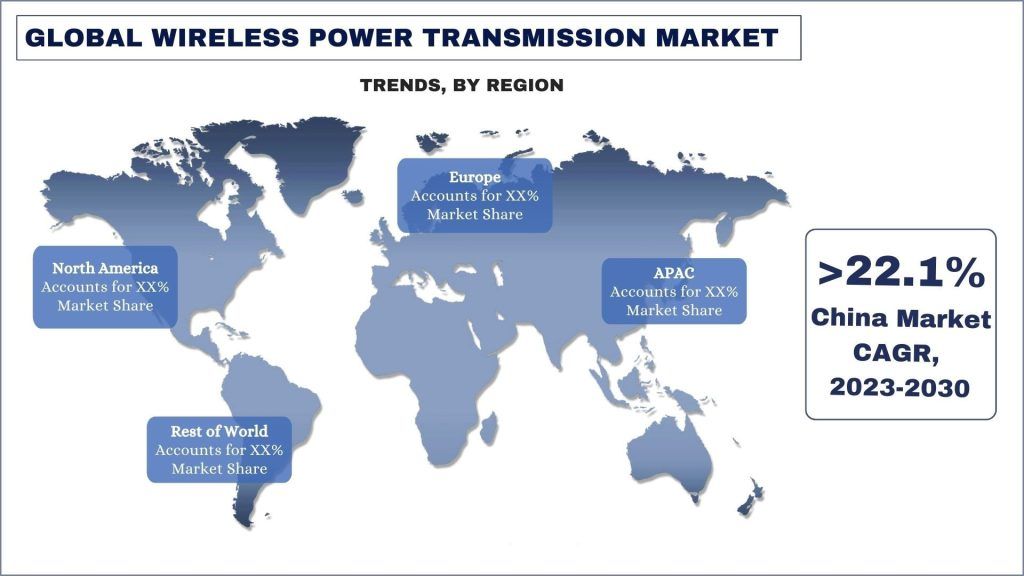
Tổng quan về Ngành Truyền tải Điện không dây
Thị trường Truyền tải Điện không dây có tính cạnh tranh và phân mảnh, với sự hiện diện của một số người chơi thị trường toàn cầu và quốc tế. Những người chơi chính đang áp dụng các chiến lược tăng trưởng khác nhau để tăng cường sự hiện diện trên thị trường của họ, chẳng hạn như quan hệ đối tác, thỏa thuận, hợp tác, ra mắt sản phẩm mới, mở rộng địa lý và sáp nhập và mua lại. Một số người chơi chính hoạt động trên thị trường bao gồm Samsung Electronics Co. Ltd., Energous Corporation, Koninklijke Philips N.V., NXP Semiconductors N.V., Powermat Technologies Ltd., Renesas Electronics Corporation, Analog Devices Inc., Semtech Corporation, TDK Corporation và WiTricity Corporation.
Tin tức Thị trường Truyền tải Điện không dây
Vào tháng 11 năm 2023,WiTricity Corporation và Nagano Japan Radio thông báo rằng Nagano Japan Radio đã ký kết một thỏa thuận cấp phép với WiTricity với mục đích phát triển và quảng bá các sản phẩm truyền tải điện không dây để sử dụng trong công nghiệp. Nagano Japan Radio sẽ tích hợp công nghệ truyền tải điện không dây của WiTricity với công nghệ thông tin liên lạc không dây, cung cấp điện và cuộn dây của mình để thương mại hóa các hệ thống sạc không dây công nghiệp.
Vào tháng 9 năm 2023,Cơ quan Dự án Nghiên cứu Quốc phòng Tiên tiến (DARPA) của Hoa Kỳ đã công bố các nhà thầu chính được chọn cho giai đoạn đầu tiên của chương trình Persistent Optical Wireless Energy Relay (POWER) đầy tham vọng. Theo DARPA, giai đoạn đầu tiên của chương trình POWER sẽ được tiến hành bởi ba nhóm do RTX Corporation, Draper Laboratory và BEAM Company dẫn đầu. Điều này rất quan trọng, vì các rơle hiệu quả sẽ đóng một vai trò quan trọng trong việc tạo ra một mạng năng lượng không dây thiết thực, linh hoạt và có thể thích ứng.
Phạm vi Báo cáo Thị trường Truyền tải Điện không dây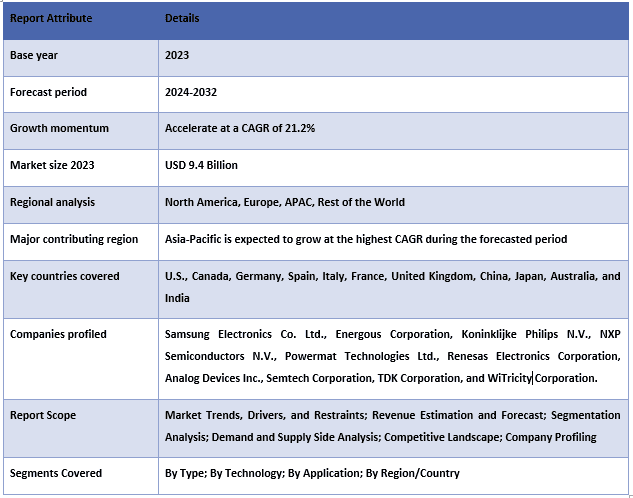
Lý do mua báo cáo này:
- Nghiên cứu bao gồm phân tích về quy mô và dự báo thị trường được xác thực bởi các chuyên gia trong ngành.
- Báo cáo trình bày một đánh giá nhanh về hiệu suất tổng thể của ngành trong nháy mắt.
- Báo cáo bao gồm phân tích chuyên sâu về các đồng nghiệp trong ngành nổi bật, với trọng tâm chính là tài chính kinh doanh chính, danh mục sản phẩm, chiến lược mở rộng và những phát triển gần đây.
- Kiểm tra chi tiết về các động lực, hạn chế, xu hướng chính và cơ hội hiện có trong ngành.
- Nghiên cứu bao gồm toàn diện thị trường trên các phân khúc khác nhau.
- Phân tích cấp độ khu vực chuyên sâu về ngành.
Tùy chọn Tùy chỉnh:
Thị trường Truyền tải Điện không dây toàn cầu có thể được tùy chỉnh thêm theo yêu cầu hoặc bất kỳ phân khúc thị trường nào khác. Bên cạnh đó, UMI hiểu rằng bạn có thể có nhu cầu kinh doanh riêng, do đó, vui lòng liên hệ với chúng tôi để có được một báo cáo hoàn toàn phù hợp với yêu cầu của bạn.
Mục lục
Phương pháp Nghiên cứu để Phân tích Thị trường Truyền tải Điện Năng Không Dây (2024-2032)
Phân tích thị trường lịch sử, ước tính thị trường hiện tại và dự báo thị trường tương lai của Truyền tải Điện Năng Không Dây toàn cầu là ba bước chính được thực hiện để tạo và khám phá việc áp dụng Truyền tải Điện Năng Không Dây ở các khu vực chính trên toàn cầu. Nghiên cứu thứ cấp chuyên sâu đã được thực hiện để thu thập số liệu thị trường lịch sử và ước tính quy mô thị trường hiện tại. Thứ hai, nhiều phát hiện và giả định đã được xem xét để xác nhận những hiểu biết này. Hơn nữa, các cuộc phỏng vấn chính chuyên sâu cũng đã được thực hiện với các chuyên gia trong ngành trên toàn chuỗi giá trị của thị trường Truyền tải Điện Năng Không Dây toàn cầu. Sau khi giả định và xác nhận số liệu thị trường thông qua các cuộc phỏng vấn chính, chúng tôi đã sử dụng phương pháp từ trên xuống/từ dưới lên để dự báo quy mô thị trường hoàn chỉnh. Sau đó, các phương pháp phân tích thị trường và tam giác hóa dữ liệu đã được áp dụng để ước tính và phân tích quy mô thị trường của các phân khúc và phân khúc phụ của ngành. Phương pháp chi tiết được giải thích dưới đây:
Phân tích Quy mô Thị trường Lịch sử
Bước 1: Nghiên cứu chuyên sâu về các Nguồn thứ cấp:
Một nghiên cứu thứ cấp chi tiết đã được thực hiện để thu được quy mô thị trường lịch sử của Truyền tải Điện Năng Không Dây thông qua các nguồn nội bộ của công ty như báo cáo thường niên & báo cáo tài chính, thuyết trình hiệu suất, thông cáo báo chí, v.v., và các nguồn bên ngoài bao gồm tạp chí, tin tức & bài viết, ấn phẩm của chính phủ, ấn phẩm của đối thủ cạnh tranh, báo cáo ngành, cơ sở dữ liệu của bên thứ ba và các ấn phẩm đáng tin cậy khác.
Bước 2: Phân khúc Thị trường:
Sau khi có được quy mô thị trường lịch sử của Truyền tải Điện Năng Không Dây, chúng tôi đã tiến hành phân tích thứ cấp chi tiết để thu thập thông tin chi tiết và thị phần thị trường lịch sử cho các phân khúc và phân khúc phụ khác nhau cho các khu vực chính. Các phân khúc chính được bao gồm trong báo cáo, chẳng hạn như Loại, Công nghệ và Ứng dụng. Phân tích cấp quốc gia hơn nữa đã được tiến hành để đánh giá việc áp dụng chung các mô hình thử nghiệm trong khu vực đó.
Bước 3: Phân tích Yếu tố:
Sau khi có được quy mô thị trường lịch sử của các phân khúc và phân khúc phụ khác nhau, chúng tôi đã tiến hành phân tích yếu tố chi tiết để ước tính quy mô thị trường hiện tại của Truyền tải Điện Năng Không Dây. Hơn nữa, chúng tôi đã tiến hành phân tích yếu tố bằng cách sử dụng các biến phụ thuộc và độc lập như Loại, Công nghệ và Ứng dụng của thị trường Truyền tải Điện Năng Không Dây. Một phân tích chuyên sâu đã được tiến hành về các kịch bản cung và cầu có tính đến các quan hệ đối tác hàng đầu, sáp nhập và mua lại, mở rộng kinh doanh và ra mắt sản phẩm trong lĩnh vực Truyền tải Điện Năng Không Dây trên toàn cầu.
Ước tính & Dự báo Quy mô Thị trường Hiện tại
Đánh giá Quy mô Thị trường Hiện tại:Dựa trên những hiểu biết hành động từ 3 bước trên, chúng tôi đã đưa ra quy mô thị trường hiện tại, các công ty chủ chốt trên thị trường Truyền tải Điện Năng Không Dây toàn cầu và thị phần của các phân khúc. Tất cả các phân chia tỷ lệ phần trăm, và phân tích thị trường đã được xác định bằng cách sử dụng phương pháp thứ cấp đã đề cập ở trên và đã được xác minh thông qua các cuộc phỏng vấn chính.
Ước tính & Dự báo:Để ước tính và dự báo thị trường, trọng số đã được gán cho các yếu tố khác nhau bao gồm động lực & xu hướng, hạn chế và cơ hội có sẵn cho các bên liên quan. Sau khi phân tích các yếu tố này, các kỹ thuật dự báo có liên quan, tức là, phương pháp từ trên xuống/từ dưới lên đã được áp dụng để đưa ra dự báo thị trường cho năm 2032 cho các phân khúc và phân khúc phụ khác nhau trên các thị trường chính trên toàn cầu. Phương pháp nghiên cứu được áp dụng để ước tính quy mô thị trường bao gồm:
- Quy mô thị trường của ngành, xét về doanh thu (USD) và tỷ lệ áp dụng Truyền tải Điện Năng Không Dây trên các thị trường chính trong nước
- Tất cả các tỷ lệ phần trăm, phân chia và phân tích các phân khúc và phân khúc phụ của thị trường
- Các công ty chủ chốt trên thị trường Truyền tải Điện Năng Không Dây toàn cầu về các sản phẩm được cung cấp. Ngoài ra, các chiến lược tăng trưởng được các công ty này áp dụng để cạnh tranh trong thị trường đang phát triển nhanh chóng
Xác nhận Quy mô và Thị phần Thị trường
Nghiên cứu chính:Các cuộc phỏng vấn chuyên sâu đã được thực hiện với các Nhà lãnh đạo Ý kiến Chủ chốt (KOL) bao gồm các Giám đốc điều hành cấp cao (CXO/VPs, Trưởng phòng Kinh doanh, Trưởng phòng Tiếp thị, Trưởng phòng Vận hành, Trưởng phòng Khu vực, Trưởng phòng Quốc gia, v.v.) trên các khu vực chính. Các kết quả nghiên cứu chính sau đó được tóm tắt và phân tích thống kê đã được thực hiện để chứng minh các giả thuyết đã nêu. Đầu vào từ nghiên cứu chính đã được củng cố với các phát hiện thứ cấp, do đó biến thông tin thành những hiểu biết có thể hành động.
Phân chia những người tham gia chính ở các khu vực khác nhau
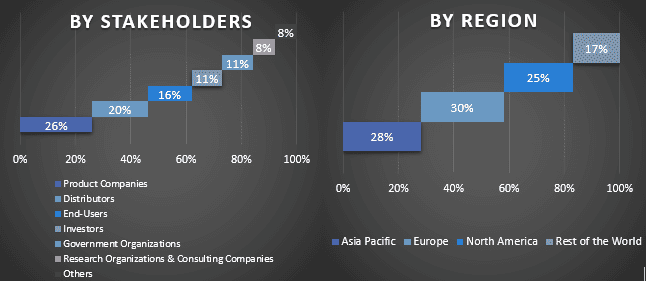
Kỹ thuật thị trường
Kỹ thuật tam giác hóa dữ liệu đã được sử dụng để hoàn thành việc ước tính thị trường tổng thể và để đưa ra các số liệu thống kê chính xác cho từng phân khúc và phân khúc phụ của thị trường Truyền tải Điện Năng Không Dây toàn cầu. Dữ liệu được chia thành một số phân khúc & phân khúc phụ sau khi nghiên cứu các thông số và xu hướng khác nhau trong các lĩnh vực Loại, Công nghệ và Ứng dụng trong thị trường Truyền tải Điện Năng Không Dây toàn cầu.
Mục tiêu chính của Nghiên cứu thị trường Truyền tải Điện Năng Không Dây Toàn cầu
Các xu hướng thị trường hiện tại & tương lai của thị trường Truyền tải Điện Năng Không Dây toàn cầu đã được xác định trong nghiên cứu. Các nhà đầu tư có thể thu được những hiểu biết chiến lược để đưa ra quyết định đầu tư dựa trên phân tích định tính và định lượng được thực hiện trong nghiên cứu. Các xu hướng thị trường hiện tại và tương lai xác định sự hấp dẫn tổng thể của thị trường ở cấp độ khu vực, cung cấp một nền tảng cho người tham gia công nghiệp để khai thác thị trường chưa được khai thác nhằm hưởng lợi từ lợi thế của người đi đầu. Các mục tiêu định lượng khác của các nghiên cứu bao gồm:
- Phân tích quy mô thị trường hiện tại và dự báo của ngành Truyền tải Điện Năng Không Dây về giá trị (USD). Ngoài ra, hãy phân tích quy mô thị trường hiện tại và dự báo của các phân khúc và phân khúc phụ khác nhau
- Các phân khúc trong nghiên cứu bao gồm các lĩnh vực Loại, Công nghệ và Ứng dụng
- Xác định và phân tích khuôn khổ pháp lý cho ngành Truyền tải Điện Năng Không Dây
- Phân tích chuỗi giá trị liên quan đến sự hiện diện của các trung gian khác nhau, cùng với việc phân tích hành vi của khách hàng và đối thủ cạnh tranh của ngành
- Phân tích quy mô thị trường hiện tại và dự báo của thị trường Truyền tải Điện Năng Không Dây cho khu vực chính
- Các quốc gia chính của các khu vực được nghiên cứu trong báo cáo bao gồm Châu Á Thái Bình Dương, Châu Âu, Bắc Mỹ và Phần còn lại của Thế giới
- Hồ sơ công ty của thị trường Truyền tải Điện Năng Không Dây và các chiến lược tăng trưởng được những người chơi trên thị trường áp dụng để duy trì trong thị trường đang phát triển nhanh chóng
- Phân tích cấp độ khu vực chuyên sâu của ngành
Câu hỏi thường gặp Câu hỏi thường gặp
Q1: Quy mô thị trường và tiềm năng tăng trưởng hiện tại của thị trường Truyền tải điện không dây là gì?
Q2: Đâu là các yếu tố thúc đẩy sự tăng trưởng của thị trường Truyền tải điện không dây?
Q3: Phân khúc nào có thị phần lớn nhất trong thị trường Truyền tải điện không dây theo Ứng dụng?
Q4: Đâu là các công nghệ và xu hướng mới nổi trên thị trường Truyền tải điện không dây?
Q5: Khu vực nào sẽ chiếm ưu thế trên thị trường Truyền tải điện không dây?
Liên quan Báo cáo
Khách hàng đã mua mặt hàng này cũng đã mua

